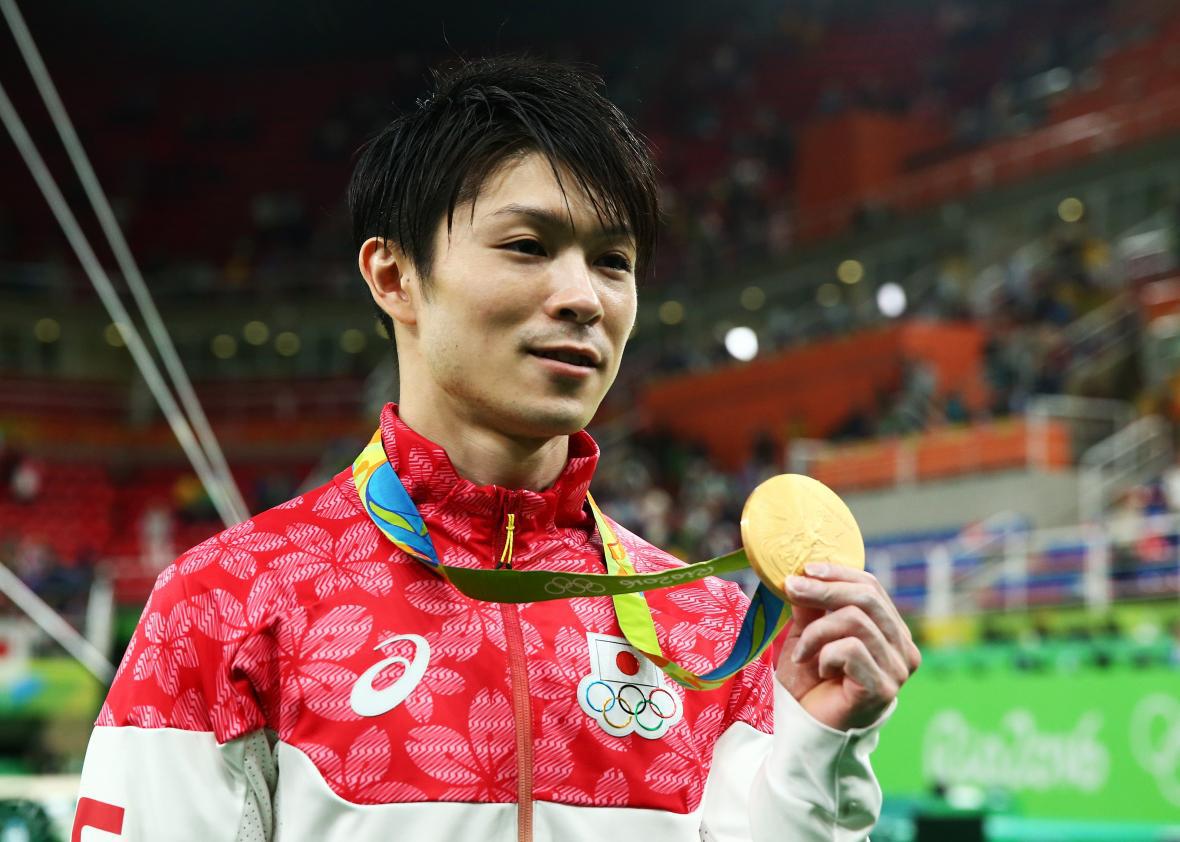For an interminable five rotations during Wednesday’s men’s gymnastics individual all-around competition, it seemed as if the unthinkable was happening. Japan’s Kohei Uchimura, a gymnast who’s been so dominant for the past decade that his nicknames are “Superman” and “the King,” was going to lose, to Ukrainian Oleg Verniaiev. Double unthinkable? Unlike in the qualifying meet, when Uchimura (unthinkably) fell off the high bar, his marquee event, the King spent much of the all-around meet in second place without biffing any of his routines.
Uchimura began the meet with a floor routine up to his usual breathtaking standard, ending with a triple full twist falling straight out of the sky.
The defending Olympic champ and 19-time world championships medalist scored a 15.766. (In case you’re wondering, that’s good. Better than Verniaiev’s 15.033. Which is also good. Sometimes, even I miss the perfect 10.)
Uchimura edged out Verniaiev on floor and vault, but the Ukrainian beat him on parallel bars, pommel horse, and rings. Going into the sixth and final rotation—none other than the high bar—Superman was losing by an unthinkable nine-tenths of a point. And then, this happened.
It was a heart-stopping routine. So much so that adorable 2008 Olympian Jonathan Horton (part of the far-superior-to-prime-time streaming commentary team) quaked, “I can’t handle this right now” as Uchimura got started. (He wasn’t the only one.) Horton and the rest of us started to breathe again once Kohei stuck his landing like the mat was made of cement.
Uchimura’s score was a massive 15.8. Verniaiev, who went up next (the two exchanged a menschlike middle-five as they switched positions), came up just short of the 14.9 he needed to keep his lead, and with that, the coup failed. Order was restored in the world, by a tenth of a point. And for the first time in nearly half a century, an all-around winner defended his gold. (The last one? Sawao Kato, also Japanese.)
You could say that Kohei Uchimura is the Simone Biles of men’s gymnastics—but you’d have it backward. Biles, as spectacular as she is, is almost the Kohei Uchimura of women’s gymnastics. Yes, she will almost certainly win all-around gold in Rio. Uchimura has already done that twice. She has three world championships. He has six. In a row. There’s men’s gymnastics, there’s difficult men’s gymnastics, and then there’s near-technically-perfect men’s gymnastics. And then, above them all, there is Kohei Uchimura. He has been so much better than everyone else, for so long, that when he almost didn’t win gold, it didn’t quite seem like reality.
That’s easy to understand if you’ve ever seen him compete. Because, as the nicknames attest, Kohei doesn’t appear to abide by the rules our world. What makes him so great? In a word: difficulty. Especially on the high bar, he does some of the hardest skills imaginable. (That’s how he was able to dwarf Verniaiev by a point.)
But there’s another word: lines. That’s gymnastics-talk for the form a gymnast’s extremities take when he or she is exhibiting top execution and extension in, for example, handstands. Almost all elite gymnasts have good lines, but some have lines that make you gasp. A prime example of this in women’s gymnastics is Nadia Comaneci, who, as Dvora Meyers writes in The End of the Perfect 10, “demonstrated a technical perfection that had heretofore not been seen in the sport. And to that, she added an ease of performance. Comaneci gave the impression that not only could she do the extremely difficult skill perfectly but also that she could do it repeatedly without error.” That passage could have easily been written about Kohei, as is evident from one look at this staggering parallel bars routine from one of his many world championships (this one in 2013):
But lines alone do not make a great gymnast sublime. What distinguishes Kohei from the Earth humans he competes against is that even with his ethereal form, he swings faster, he twists cleaner, he flies higher, and he sticks harder. And he has done so for six. Straight. Years. (Also, he has amazing hair, and he might love Pokémon Go a little too much.)
As you can imagine, Uchimura is a legend in his native Japan. He’ll be 31 when the Olympics come to Tokyo, which, despite the delightful majesty of 41-year-old Uzbek vaulter Oksana Chusovitina, is about 12,000 in gymnastics years. After these games, a reasonable Japanese gymnastics champion of his vintage might think it time to take his chest full of medals and go make soda commercials for the rest of his life. At least that’s what a mortal one would do. But that’s the thing about Kohei Uchimura. Despite a few uneasy moments on Wednesday that could have hinted otherwise, we have no definitive proof that he’s mortal at all.
